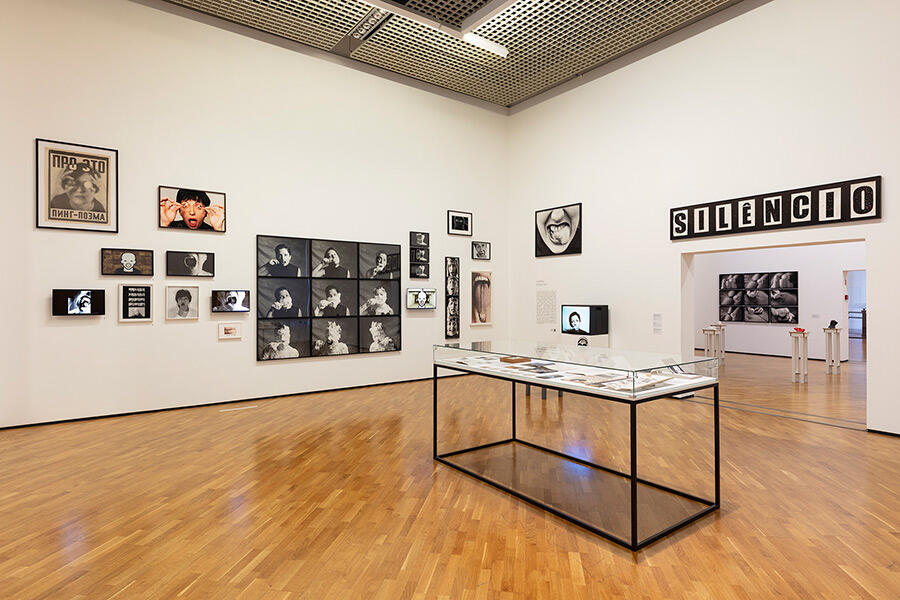Lenora de Barros’s Impossible Conjuring Acts
At Pinacoteca de Estado, São Paulo, the artist toes the fragile line between language, bodies and the environment
At Pinacoteca de Estado, São Paulo, the artist toes the fragile line between language, bodies and the environment

During the 1960s and ’70s, Brazilian artists such as Lygia Clark and Hélio Oiticica sought to collapse the boundary between the body and the environment. In Clark’s Baba Antropofágica (Anthropophagic Slobber, 1973), for instance, strangers disgorged strings of chewed gum onto the body of a supine participant. Picking up where Clark left off, fellow Brazilian artist Lenora de Barros has produced a diverse oeuvre over the past four decades that springs from the tenuous symbiosis between language, the body and the environment, observed through a conceptually playful lens. This is borne out in some 40 works – ranging from graphic poems and performance to photography and video art – currently on view at Pinacoteca de Estado in São Paulo.
Titled ‘My Language’, the exhibition, organized by recently appointed curator Pollyana Quintella, occupies three galleries. The first includes a short, commissioned video, The Face. The Tongue. The Belly (2022). Over three acts, De Barros manipulates pieces of clay to form each of the eponymous body parts. The camera’s depth of focus creates moments of filmic humour. In the tongue segment, for example, a giant dangly piece of brick-red clay protrudes towards the audience, as if it has sprung from the artist’s mouth, while she strokes and moulds it until it breaks off. Such interplay of sensuality and violence echoes De Barros’s famous black and white photographic series ‘Poema’ (Poem, 1979–2014) – on display in the adjacent gallery – in which she presses and licks typewriter keys with her tongue. Emerging from the artist’s lipstick-painted mouth, the tensed phallic muscle hints at both corporeal pleasure and vulnerability. While De Barros plays with historical associations of mechanical modernity and the act of authorship in writing with masculinity, the work’s fusion of soft and hard, mouth/vagina and phallus is wondrously androgynous.

Quintella’s exhibition concept – which displays works associatively rather than chronologically – allows for a deeper understanding of thematic and formal alliterations in De Barros’s oeuvre. A 1975–2014 photo-performance, in which the artist gradually obscures her face with toothpaste, hangs near a 1984 video and a larger, nine-panel photo-performance from 1990–2022, which both document the same process. All titled Homage to George Segal, the works play on De Barros’s recurring themes of masking, while also evoking Segal’s trademark white plaster sculptures. In the video, De Barros jump-cuts between different stages of the smothering process, hinting at epistemic uncertainty: can a single face – or other entity – exist in multiple forms?

This question seemingly also drives two black and white photographic works installed facing one another: Thing of Nothing and Thing in Itself (both 1990). The titular words – stamped in black capital letters on table-tennis balls – underscore how language inevitably re-signifies. The works’ magic stems from De Barros’s formal choices. In Thing of Nothing, she’s covered the balls in white gauze that oozes milky liquid into a water-filled bowl, her own hand at the upper edge of the frame, as if she were breaking eggs. In Thing in Itself, she rolls a lone ball, covered by a black fishnet stocking, across her entire body – the foreign object resisting absorption into the artist’s fleshy folds. I can’t help but echo de Barros’s series of journal columns …umas (1993–96) – a selection of which are on display here – in which she sums up the force of Clark’s material ambivalence as: ‘Being both the egg and the hand that breaks it.’ In an impossible conjuring act that lies at the heart of invention, De Barros is suddenly both.
‘Lenora de Barros: My Tongue’ is on view at Pinacoteca de Estado, São Paulo, Brazil until 9 April.
Main Image: Lenora de Barros, ‘My Tongue’, 2022–23, exhibition view, Pinacoteca de Estado, São Paulo. Courtesy: Pinacoteca de Estado, São Paulo; photograph: Isabella Matheus
























